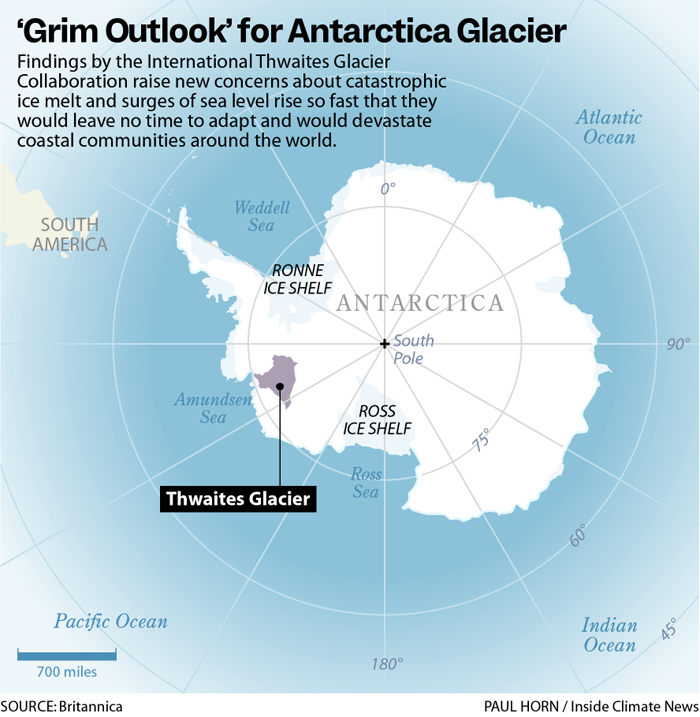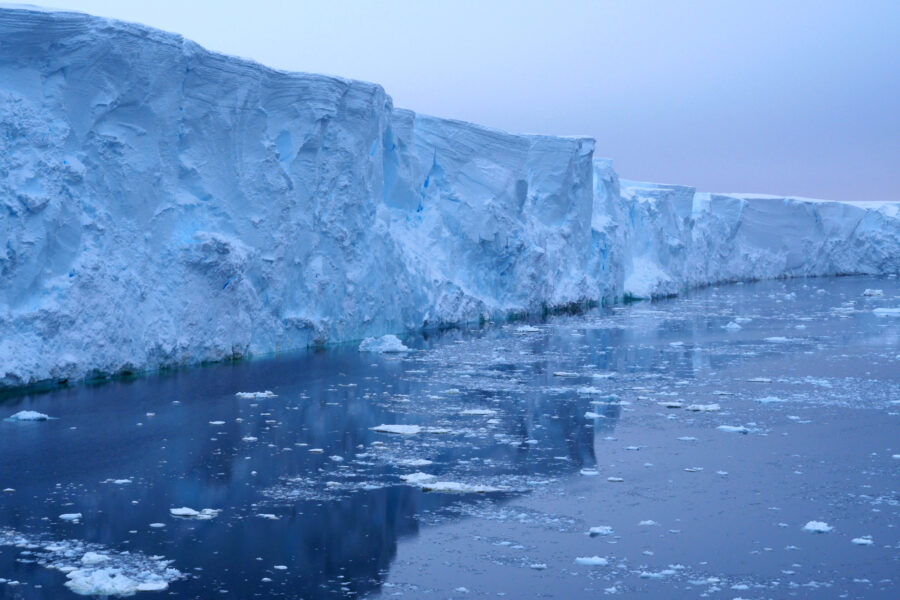‘Grim Outlook’ for Thwaites Glacier
After six years of probing, poking and sampling a Florida-sized chunk of ice in West Antarctica with submarines, satellites and drills, scientists with the International Thwaites Glacier Collaboration said Thursday that a worst-case meltdown scenario still can’t be ruled out, since emissions of climate-heating greenhouse gases continue to set new records each year.
Combined with meltwater from ice in other parts of Antarctica and Greenland as well as from mountain glaciers around the world, and the thermal expansion of warming oceans, a Thwaites Glacier meltdown could spur sea level to rise six feet higher than today by 2100, the researchers said.
Many coastal communities would not be able to adapt to that much sea level rise in that time span, and it’s likely that millions of people would be displaced, as extreme coastal flooding devastated low-lying cities, residential neighborhoods, croplands and natural ecosystems. That increase in water levels would swallow some small islands entirely in the span of just a few decades.
Explore the latest news about what’s at stake for the climate during this election season.
The Thwaites Glacier is more than 6,000 feet thick in places, holding enough ice to raise sea level by 2 feet if it melts completely. It is also a keystone holding back the West Antarctic Ice Sheet, much of which sits on a bed below sea level, that would raise oceans by about 11 feet if it all reached the sea.
The glacier has been retreating for 80 years, a process that accelerated significantly in the last three decades and will speed up even more in the years ahead, the researchers said during the release of a science briefing of key results from studies done by hundreds of researchers working on different parts of the glacier and in the adjacent ocean.
The international collaboration was led by the British Antarctic Survey and the United States’ National Science Foundation, and included scientists and research instruments and equipment from several other countries, including Germany and South Korea.
“Our findings indicate Thwaites is set to retreat further and faster,” said Rob Larter, a coordinator of the research team and a marine geophysicist with the British Antarctic Survey. Some of the team’s studies of the past few years showed new vulnerabilities that could speed up the glacier’s retreat sooner than expected, he added.

Overall, the science briefing suggests that a complete collapse of the Thwaites Glacier in this century may be a bit less likely than previously thought, but that the latest models predict accelerating ice loss through the 2100s and 2200s, potentially leading to a “general collapse of the West Antarctic Ice Sheet in the 23rd century.”
Some of the data was collected by remote-controlled submarines, and shows how tides can drive pulses of water beneath the glacier to cause more melting. Other scientists studied surface melting, and how pooling water and more rainfall can weaken the ice from above. In some scenarios, towering ice cliffs could collapse like rows of dominoes, disintegrating city-size areas of ice in sudden bursts.
The scientists also noted that the Thwaites Glacier’s floating extension—its ice shelf—is on the verge of breaking up completely. That wouldn’t directly accelerate sea level rise significantly, they said, because that ice is already in the ocean, but it’s uncertain how the glacial front at the edge of the sea will react when the floating ice shelf is gone.
Irreversible Changes
“It’s really concerning that the latest models are all kind of pointing toward irreversible retreat having been triggered already,” said University of Cambridge climate researcher James Kirkham, the chief science advisor to the International Cryosphere Climate Initiative.
Already, the rate of sea level rise is overwhelming coastal ecosystems like mangroves and wetlands that help buffer storm-driven surges of water, he added.
“I was in Houston earlier this year, and because a lot of that land is subsiding, you’ve got rates of sea level rise which are about eight millimeters a year,” he said, adding that coastal ecosystems like marshes can’t keep up with that rate of change. Climate experts in the area say those ecosystems are drawing, he said.
As soon as that happens, he added, “They’re going to lose very large areas of wetlands, and you’ll start losing those very quickly, probably on a timescale of decades, rather than the long term.”
The root of the problem is that “8 billion badly behaving apes” are ravaging the planet, said Dominic Hodgson, the acting science director of the British Antarctic Survey.
“We form tribes, and we do a lot of fighting,” he said. “We also go around burning things. First it was dung, then it was the trees, then we moved on to oil and gas. We keep destroying our planet. This burning of biomass and fossil fuels has resulted in carbon dioxide concentrations in our atmosphere that are more than 1.5 times what they should be … so we’ve kicked our planet way out of its natural balance.”
Hodgson said the Thwaites collaboration was part of the science community’s overall “grand challenge” of determining “how much and how fast this sea level rise will be, where it will come from and where the impacts will be felt.”
He said geological records show that sea level doesn’t always rise steadily, but instead, “comes in jumps, and these jumps can be quite severe, several meters in the course of a few hundred years.”
Recent studies off the shore of West Antarctica have reinforced the idea that there have been phases of rapid melting in past geologic eras of rapid warming. Detailed mapping of the seafloor shows patterns of ridging that suggest ice shelf retreat of more than 1 mile per year.
The $50 million research effort may not have answered all the important questions about West Antarctica’s ice, but there were some true eureka moments, said glaciologist Kiya Riverman, an assistant professor of environmental studies at the University of Portland, who operated a robotic submarine that for the first time directly observed the grounding line of the Thwaites Glacier’s floating ice shelf.
The grounding line is where the bottom of an ice shelf extending into the ocean is anchored to a ridge on the seafloor, which prevents the shelf from retreating. But those grounding lines are very vulnerable to warming ocean water and shifting currents, and being able to see exactly what is going on there will help refine sea level rise projections.
“For glaciologists, I think this had the emotional impact that perhaps the moon landing had on the rest of society,” Riverman said. “We were seeing this place for the first time.”
She said she started studying glaciers because she loved “the basic questions we were asking, and how little we knew about glaciers.”
Sometimes, while doing hard physical labor in the extreme weather atop the Thwaites Glacier, she thought that, “for all intents and purposes, I should have been miserable, right? But it was the time of my life,” she said.
“We had American planes and British drills, Korean vessels, and German instruments and scientists from all of those places,” she said. “And so as a result, we’re actually able to start answering some of those fundamental questions. And there’s nothing more satisfying than that.”
About This Story
Perhaps you noticed: This story, like all the news we publish, is free to read. That’s because Inside Climate News is a 501c3 nonprofit organization. We do not charge a subscription fee, lock our news behind a paywall, or clutter our website with ads. We make our news on climate and the environment freely available to you and anyone who wants it.
That’s not all. We also share our news for free with scores of other media organizations around the country. Many of them can’t afford to do environmental journalism of their own. We’ve built bureaus from coast to coast to report local stories, collaborate with local newsrooms and co-publish articles so that this vital work is shared as widely as possible.
Two of us launched ICN in 2007. Six years later we earned a Pulitzer Prize for National Reporting, and now we run the oldest and largest dedicated climate newsroom in the nation. We tell the story in all its complexity. We hold polluters accountable. We expose environmental injustice. We debunk misinformation. We scrutinize solutions and inspire action.
Donations from readers like you fund every aspect of what we do. If you don’t already, will you support our ongoing work, our reporting on the biggest crisis facing our planet, and help us reach even more readers in more places?
Please take a moment to make a tax-deductible donation. Every one of them makes a difference.
Thank you,
David Sassoon
Founder and Publisher
Vernon Loeb
Executive Editor
Share this article
Disclaimer: The copyright of this article belongs to the original author. Reposting this article is solely for the purpose of information dissemination and does not constitute any investment advice. If there is any infringement, please contact us immediately. We will make corrections or deletions as necessary. Thank you.
Title:‘Grim Outlook’ for Thwaites Glacier
Url:https://www.investsfocus.com










